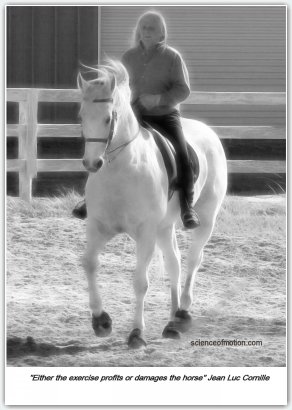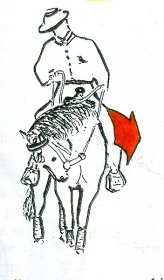The Tide
The Tide
Jean Luc Cornille

The intellectual level of equestrian education is like a tide, high and low. The high tide waves further the cleverness of Mother nature through an advanced understanding of the horse physique. Instead, the waves of the low tide run low on the ground. It is the equitation of posture and gesture, placing the horse head with side reins, touching the limbs with a whip. Low intellect equitation wants you to believe that such is your level because once you have surfed the big wave, you no longer find any interest in the low wave.
The cycle of locomotion if for a great part, the clever use of energy stored in the tendons, aponeurosis, and even muscles' belly during the first half of the stride. Intelligent equitation further the cleverness of Mother nature educating and refining the work and coordination of the back muscles managing the thrust generated by the hind legs. In his first dynamic analysis of the equine thoracolumbar spine, Richard Tucker drew the blueprint of modern education. "An initial thrust on the column is translated into a series of predominantly vertical and horizontal forces which diminish progressively as they pass from one vertebra to the next." (Richard Tucker- Contribution to the Biomechanics of the Vertebral Column, Acta Thoeriologica, VOL. IX, 13: 171-192, BIALOWIEZA, 30. XL. 1964) The main back muscles, the longissimus dorsi, and the multifidius have the capacity to convert the thrust generated by the hind legs into horizontal forces, forward motion, and vertical forces, resistance to gravity, and therefore balance control.
Intelligent equitation sublimates limb movement through the subtle education of the muscular system controlling the forces loading the legs. Instead, low intellect equitation acts on the legs making dysfunctional horses mimicking a move that normally results from proper coordination of the horse physique. By altering the cycle of locomotion, low tide equitation downgrades the horse's talent and jeopardizes its soundness. The equitation of correct aids, postures, and gestures also numbs riders feeling and intelligence. Promoting lateral bending through hand action, low intellect equitation forces the horse into inverted rotation. Lateral bending is always associated with a movement of transversal rotation, and lateral bending of the neck exceeding the degree of bending of the thoracic vertebrae induces inverted rotation of the dorsal spine. The horse is then a dysfunctional athlete mimicking lateroflexion. 
For many years, those who felt that it was something wrong, that the horse was not comfortable trying to protect something, the ones who have the intelligence and intuition to surf the high wave, have been numbed down by the experts of low intellect equitation. The ones who have an intuitive mind have been criticized and even mocked by the low-wave experts. Einstein said that an intuitive mind is a sacred gift, but society instead deals with faithful servants. Einstein's remarks apply to equestrian education. Instead of furthering the gift of intuition, riding and training techniques that are not smart enough to deal with the cleverness of mother nature have dumb down the intelligence of both the riders and the horses.
Science renders justice to intuition. Science explains what many already know by feel but cannot apply because the principles or riding don't match their intuition. Advanced understanding of equine biomechanics exposes the ineptness of conventional beliefs, not all but some and, instead of updating old beliefs to new knowledge, low wave trainers protect ignorance by integrating new ideas to old beliefs. Colonel Danloux wrote, "respect for tradition should not prevent the love of progress." Many classical trainers do not respect tradition; they use tradition as an umbrella to resist progress. Instead, genuine respect for our ancestors' wisdom is updating their teaching to actual knowledge.
I often say during a lesson, don't use words, have a real conversation. Use phrases that contain emotion, intuition, nuances, feeling. The aids are just words, formulas, and thinking that their studious application may stimulate a proper response from the horse is infantile. Intuitively but also instinctively, a horse protects whatever muscle imbalance is there at the instant that the aids are applied. We can refer to this situation as the horse's body state. A horse will always respond to the rider's aids protecting his body state. The horse's initial response is a piece of valuable information as it tells us what is the body situation at this instant. Intelligence equitation explores what adjustment or added insight could lead the horse's brain toward the proper response from this information. Instead, low wave equitation interprets the horse resistance as disobedience to the aids and became assertive, furthering the horse's protective reflex mechanism. Instead of becoming a conversation, the horse's initial reaction triggers a monologue serving the rider's ego but letting the horse unprepared for the move.
Education is not the learning of facts, but the training of the mind to think". (Albert Einstein) So are the aids. They are not the finality of the art of riding; they are the beginning. They are teaching techniques aiming at creating an artist and not a servant. I should write servants with an (S) because the aids create two servants, the horse, which focuses on obedience at the cost of physical discomfort or pain, and the rider who cannot think beyond obedience to the correct aids. The equitation of the correct aids is an equitation of formulas. The actual dialogue with the horse is much richer than that. There is a quote that says that when we don't understand, we judge. This direct our relations with horses. When we don't have in mind a sound understanding of the way the horse's physique as well as mental processing actually functions, we judge the reaction instead of using the reaction as part of a dialogue that is going to direct the horse's mind and therefore body toward the appropriated response.
Sometimes, when I write a complex study, critics argue that it is too complicated. Simplicity is precisely how low wave trainers keep their students riding low waves. The culture of simplicity is a control technique aiming at making riders believe that low wave is all they can ride. Once, the comment of a keyboard rider questioned ravenously, "And how are you going to explain that to a kid?" Precisely, kids have no problems understanding explanations that older riders cannot mentally accept because it challenges their comfort zone. Instead, children's comfort zone is conversing with the horse, and they have no problem evolving from an equitation of gesture to a dialogue based on nuances in muscle tone and, therefore, energy.
This observation makes me realize that many "ordinary" riders are capable of perception and sophistication that conventional or classical equitation is regarded as the privilege of few extraordinary riders. Instead of applying the aids, I ask them to concentrate on their senses and analyze their perception in respect of sound understanding of the equine biological mechanism, and they start communicating with their horse. They have a genuine dialogue, and with their ability to listen and not judge, they figure the nuances or add the insight that guides the horse brain toward the proper coordination.
Instead of dumbing down, horses touching their legs with a whip, placing their head with a set of reins. Instead of dumbing down riders focusing on the "correct aids," Ordinary horses and ordinary riders have an enormous potential indeed. They can surf the high wave and enjoy every second of it. The training has to evolve, but also the teaching. A leader is not the number one of the packing order. The leader is the one who has a sound understanding of the equine biological mechanism and the will to explore respect for the horse. Then, and only then, the horse can think at its full potential and develop for the rider considerable esteem.
Jean Luc



 twitter
twitter facebook
facebook google
google pinterest
pinterest yahoo
yahoo linkedin
linkedin